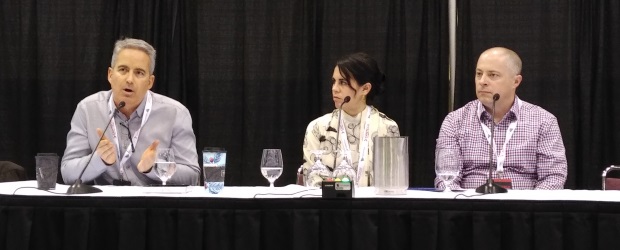Artificial intelligence (AI) might be the latest tool in the enterprise software toolbox, but at heart it’s solving the same problems enterprises have always faced, and should be implemented in an equally timeless way, according to the founders of two AI software firms.

Wysdom.AI founder and CEO Ian Collins
“Enterprise software companies are enterprise software companies,” Wysdom.AI founder and CEO Ian Collins said during a panel titled “Beyond the Hype Cycle: Deploying AI in the Real World” at the 2018 Cantech Investment Conference on Wednesday.
“We’ve gone through many different tools, and AI is the latest and greatest, but solving a problem, and building an enterprise software organization capable of building, deploying, maintaining, and in this case training that solution is not a new challenge,” he said. “It’s been around for as long as enterprises have been buying software – now it just happens to be in the cloud.”
Regardless of what’s under the hood, Nudge.ai CTO and co-founder Steve Woods said during the same panel, enterprise software firms have always served both themselves and their customers best by focusing on the customer’s problem and emphasizing their solution’s user experience, rather than focusing on how it was developed.

Nudge.ai CTO and co-founder Steve Woods
“In a lot of ways, it’s classic product management,” Woods said. “It’s all about going out, listening for the underlying problem they’re dealing with, and explaining how what you could do might come close to a solution.”
“It’s never been easy, and there’s nothing new about it,” he added. “AI just gives you new wrenches in the toolkit.”
As an example, Collins said Wysdom provides what he calls “cognitive care” for telecommunications giant Rogers Communications Inc., by using machine learning to intercept and answer questions from digital channels such as Facebook and Google searches before the frustrated customers behind them reach out to a call centre.
“In the old days we could says ‘if this, then that,'” he acknowledged. “Now it’s a little less clear. It’s hard to say, ‘you’re going to have a whole bunch of inbound questions from customers, and we’re going to satisfy them, and here are all the models and how they’re going to react every time so that you know how we’re doing that.’ It’s not that explainable.”
As a result, he said, Wysdom hasn’t implemented the solution all that differently from how it would have 20 years ago.
“We’re going to say we hit 80 per cent recall and 80 per cent precision,” he said, “and we’ll describe to our clients the benefit or effect it’s going to have overall.”
“That type of client relationship, and the ongoing maintenance, and the engagement teams, are all very similar to what they used to be,” he said. “The underlying tech has changed – we’re in the cloud now – whereas we might have been running from a Rogers datacentre 20 years ago – but otherwise very little has changed. It’s just the technology that’s new.”
